

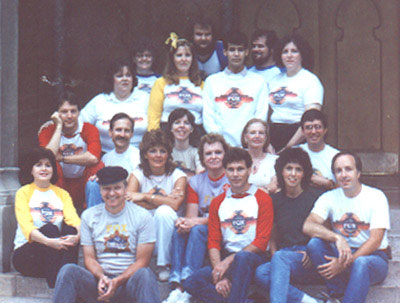
The FOF Gang in 1985. That's me at the top in the center.
Friends of the Fox began as a community project of the Atlanta Woman's Chamber of Commerce's Fine Arts division. It's chairperson, Jo Ann White, contacted Ed Neiss, who recently had become the Fox's General Manager, to see what the Chamber could do to help the Fox. Ed and Jo Ann came up with the idea of Friends of the Fox. It was envisioned the group would be guided by the WCC until such time it could operate as an independent group.
As the group got underway, members of the WCC went to street fairs and other public events to solicit members to the group that would volunteer their time to the Fox. In the fall, FOF was ready to have its first work session at the Fox. We had over 30 people show up to do all sorts of things.
 The group
was very diverse with people from all walks of life and all ages.
We had members as young as 8, my friend's son Pablo Leet and his
12 year-old sister Kimberly, to an incredible woman who just turned
80 years-young, Rachel Lehman. We offered the Fox a diverse set
of work skills and we soon found our group divided into to two
sets of workers. One set was suited for doing physical restoration
work on the Fox while the other was more suited to doing office
clerical work.
The group
was very diverse with people from all walks of life and all ages.
We had members as young as 8, my friend's son Pablo Leet and his
12 year-old sister Kimberly, to an incredible woman who just turned
80 years-young, Rachel Lehman. We offered the Fox a diverse set
of work skills and we soon found our group divided into to two
sets of workers. One set was suited for doing physical restoration
work on the Fox while the other was more suited to doing office
clerical work.
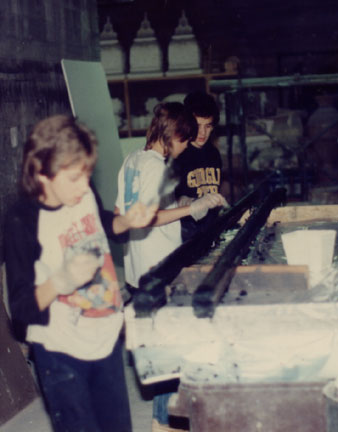 FOF
would meet one Saturday out of the month to do work at the Fox.
We would show up bright and early at 9am, gathering in the Fox's
business office. We would have a doughnut and some coffee while
the others straggled in, then we would go about our various tasks
for three hours before our work sessions ended around noon.
FOF
would meet one Saturday out of the month to do work at the Fox.
We would show up bright and early at 9am, gathering in the Fox's
business office. We would have a doughnut and some coffee while
the others straggled in, then we would go about our various tasks
for three hours before our work sessions ended around noon.
Over the years, there were five Presidents, three Restoration Chairmen who served as the Vice-President of the group. The first three Presidents were the group's founder, Jo Ann White, Lisa Clark, and Kim King. In the second year of the group's life, Lisa Clark assumed the Presidency from Ms. White and I was asked to be her Restoration Chairman. For the third year, Kim King became President while I retained the Restoration Chairman's position.
During these three President's tenures, the group was under the auspices of the Women's Chamber of Commerce. It was decided that at the end of the third year, WCC wanted to step back from FOF and let it be an independent group. Until that time, only WCC members could be the head of the group and once FOF became a group unto itself, I assumed the Presidency of FOF and held that chair for five years. Beth Ruddiman served as our Restoration Chairman and when I stepped down from my post in 1990, Beth assumed the Presidency. Since we have never had any other type of election and we still do meet as FOF, I guess she is still the president after 14 years!
At the start of the group, I volunteered to create and publish the group's newsletter. I started publishing it on a quarterly basis and continued to do this for about two years until we felt we didn't need a newsletter to keep our members informed of what we were doing. Today all the remaining FOF members have email and FOF member Ed Kuehn has taken the responsibility to coordinate all of us getting together for quarterly brunches.
During the first two years of FOF, we had nearly 200 members on our roster and there was a genuine concern of having so many people at the Fox doing work as volunteers at one time. Because of what we were doing, we literally were spread out all over the building and in parts of the complex that the public is never allowed in because of concerns for their safety. This is a place that has a room of large exposed copper bars used to distribute the huge amount of electricity that flows through the building, so you can just imagine what other items there are that could pose a real safety risk if people did not pay close attention to their surroundings. Furthermore, people have gotten lost for hours downstairs in the maze of passages below the auditorium. Fortunately, it never became a real issue for us. Every one of our FOF volunteers always acted with a lot of care and respect for the Fox as we all valued our unlimited access to the building.
Here is a partial list of the projects Friends of the Fox performed over the year:
Polishing the Brass Ticket Kiosk
One of the first projects we tackled was cleaning and polishing
the solid brass ticket kiosk located at the front of the arcade
on Peachtree Street. Back in the days the theater was run as a
theater, the management did not want nor see the need to invest
the time and effort to keep the kiosk polished. Brass tarnishes
pretty quickly and in the old days, the kiosk would have to have
been polished on a pretty constant basis, almost weekly, in order
to keep the mirror-like reflect that some parts of the kiosk has.
The modern way to care for it is to first polish it, then protect
the surfaces with a polyurethane sealant. With this as a cover,
the brass is not exposed to the oxidizing air, and it will retain
its lustrous shine for many years. Left unprotected, it will become
visibly tarnished in less than a week. With its close proximity
to the traffic on Peachtree Street, a scant ten feet away, the
process is even more accelerated.
We worked on the kiosk for several work sessions. Because of the
ornamental designs on the kiosk, some areas had to be cleaned
by hand while using an electric orbital buffing machine to clean
other sections of the kiosk. Finally, it was felt that we had
gotten most of the decades of dirt, grime, and oxidation off to
a point, a professional brass company could be called in to give
the kiosk a quick buffing and then seal the Brass. Alas, when
it was done, the work was very sub-standard and the kiosk had
to undergo yet another servicing, but that is another story we
will get to in a bit.
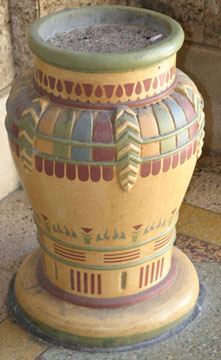
 Painting
Urns
Painting
Urns
Another project we undertook at the same time was helping to finish
new replacement cigarette urns for use in the lobby and ballroom
areas. The original urns were made of plaster and because of its
relative delicate nature, the urns were easy to nick and break
chunks from. At some point in time, they had been painted a rather
terrible orange color that was really out of place, so that compounded
the need to replace the existing urns with new ones that blended
in better with the Fox's décor.
The Fox had a staff member that was considered the resident plaster worker. In time, he created new molds for every piece of plaster detailing in the Fox. Using a mold he made using an existing urn that was in good condition, he began to manufacture new urns. Unlike the plaster originals, it was decided to form the new ones from cement so they would last far longer. Once an urn was poured, cured, it was removed from the mold. The urn was sanded to erase mold marks, and repaired if there were any flaws on its surface.
This is the point where FOF took over the process. Our members would paint the urns with a sealant to protect the cement, and then paint the urns with primer. Once that was done, the urns would then get a final coat of paint. Once the base paint coat was dry, each urn was hand painted with the ornate detail trim that made them look so incredibly beautiful.
On a recent visit to the Fox in March of 2005, I discovered some of the urns we painted are now located outside of the Ponce deLeon entrance to the auditorium. The Fox is now a non-smoking environment, so the cigarette urns have been removed from the public areas in the theater to prevent somebody from inadvertantly lighting up. Seeing the condition of the urns on the stoop where they allow people to smoke, I can see they are showing their age. During our excursion through the building, when we went out on the Grand Terrace, I found a couple of non-painted urns there. It would seem the Preservation Staff has decided not to take the time to paint and seal the replacement urns. Its a shame because even on these urns, Rick Flinn took exacting detail to research how these items looked when the Fox was new. In the photos above, you be the judge. Which urn is more pleasing to the eye?
Painting Rooms
While we did not paint any of the ornate walls inside the auditorium
or the arcade, we did do a lot of painting in other areas of the
Fox. We painted some of the dressing rooms, a set of restrooms
downstairs in the non-public areas, and we also painted the lounges for
the Egyptian Ballroom and Grand Salon.
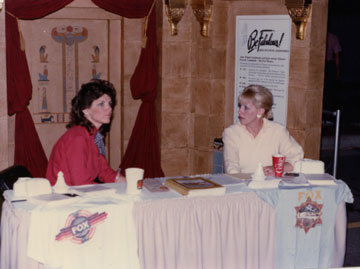 Representing
the Fox at various Street Festivals
Representing
the Fox at various Street Festivals
From the start of FOF, we got to be the face of the Fox at a lot
of the big festivals that were popular in midtown. Twice we set
up shop for the Much Ado About Midtown festival
that took place right on Peachtree Street and a few of its side
streets. We would pass out literature on the Fox, display promotional
flyers for upcoming events, invite people to not only join FOF,
but Atlanta Landmarks. We are able to raise a nice amount of money
from the sale of T-Shirts and Sweatshirts.
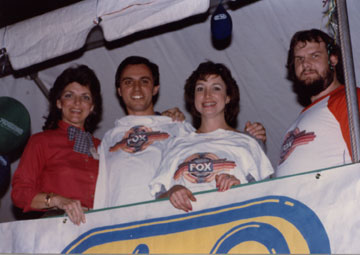 We
set up our displays at the first "A Taste of Atlanta"
that took place next door to the Fox in the BellSouth parking
lot. For that event, we used the Fox's promotional display that
used to advertise the Fox with at various conventions and trade
shows around the United States. At that event, the local radio
station WQXI, FM 94.5, set up a large scaffolding with a remote
broadcasting setup on the top of it. When we were there on Friday
Evening, two of their top DJs, Craig Ashwood and Christy Tanner,
were broadcasting live from the event. I don't know how it happened,
but FOF President Kim King was able to climb up to give them FOF
T-Shirts and make them "Honorary Friends of the Fox".
I got forced to climb up to meet them and to get our picture taken.
This was a rather interesting proposition because you just don't
get a fat man to climb scaffolds! I was able to make it up and
then get back down without falling and landing on anyone, much
to the relief of everyone.
We
set up our displays at the first "A Taste of Atlanta"
that took place next door to the Fox in the BellSouth parking
lot. For that event, we used the Fox's promotional display that
used to advertise the Fox with at various conventions and trade
shows around the United States. At that event, the local radio
station WQXI, FM 94.5, set up a large scaffolding with a remote
broadcasting setup on the top of it. When we were there on Friday
Evening, two of their top DJs, Craig Ashwood and Christy Tanner,
were broadcasting live from the event. I don't know how it happened,
but FOF President Kim King was able to climb up to give them FOF
T-Shirts and make them "Honorary Friends of the Fox".
I got forced to climb up to meet them and to get our picture taken.
This was a rather interesting proposition because you just don't
get a fat man to climb scaffolds! I was able to make it up and
then get back down without falling and landing on anyone, much
to the relief of everyone.
The last event we participated in was the Dogwood Art Festival in Piedmont Park. One of the highlights of that event was the appearance of the new Six Flags Over Georgia Mascots, Bugs Bunny and Sylvester the Cat. They played around with us and did such things as get on a set of skateboard two of the kids that were with us brought. It would seem that they were notorious for doing things the park didn't like, so they had a uniformed Six Flags "officer" with them that kept telling them "No!" much like you would do to the family pet.

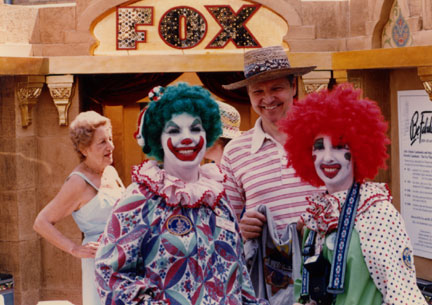

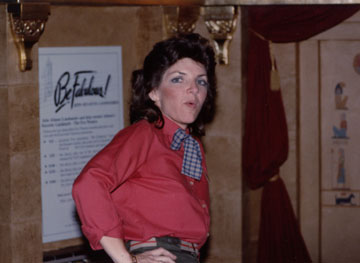
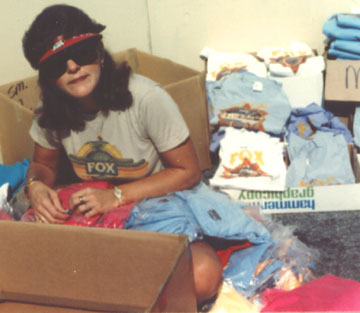
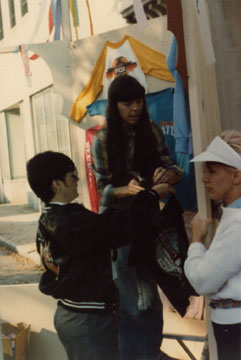

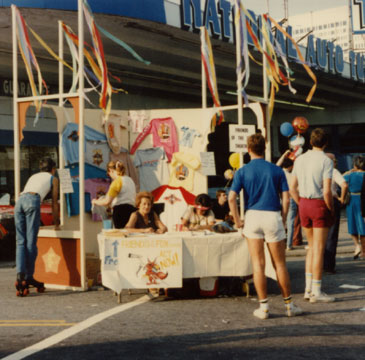

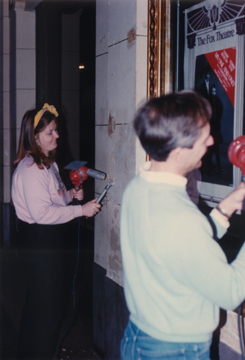 Restoration Work On The Arcade
Restoration Work On The Arcade
Just like many other ornamented walls at the Fox, the arcade had
received many coats of paint that had to be removed so the plaster
walls could be repaired and restored. This was done with great
care by using chemicals, electric heat guns, and paint scrappers.
We worked on the lower portion of the walls while the house staff
concentrated on the really high up work. The process was slow
and methodical. The chemicals had to work to loosen the paint
to a point that when it was heated with a high temperature heat
gun, it would release from the plaster and shrivel up. You could
then use a paint scrapper to scrape the paint off the wall. With
its huge 140-foot depth, the Arcade is a huge area that every
surface that was not a door or glass window had to have this done
to it. It took several months to complete, but it was well worth
the effort. We did not do any of the final painting or stencil
work; our participation was limited to stripping the walls.
Restoring Furniture and Other Decorative
Items
We got the fun job of helping the staff in the restoration of
the Fox's furniture. In the area called the Private Screening
Room, furniture was put into a staging area for restoration. We
would help strip off old worn out materials and take the padded
furniture down to its bare wooden frames. From that point, the
Atlanta Area Technical School took on the task or rebuilding the
furniture one the house staff mended or repaired any of the furniture's
damaged frame and refinishing what wood might remain exposed such
as chair arms or legs.
We also did a good bit of cleaning and stripping parts of a lot of electrical lights and metal fixtures. Rick Flinn was able to find several old items that while not original Fox appointments, they were appropriate to be used in it. Most of these electrical items dated back to close to the time the Fox was built in the 1920s and still used its original electrical wiring that by then was rather unsafe to use. We would strip the lighting fixtures and remove all the electrical components, then go about removing any paint or dirt down to the original metal. Later on, we saw some of these fixtures located in the Spanish Room after its big overhaul in 1988.
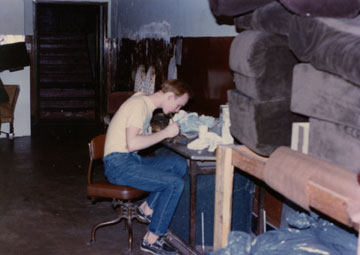

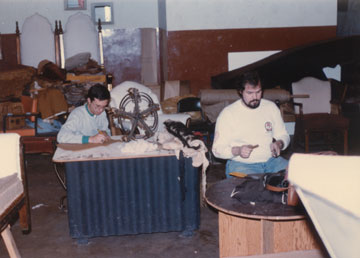
We also did prep work on the "new" grand chandeliers that now hang in the auditorium. These chandeliers arrived at the Fox as simple metal skeletons. After we cleaned and did the prep work on the metal, the house staff put the final finish on the metal frame, fitted the stained glass to the frame and installed the electrical components to each of the massive fixtures.
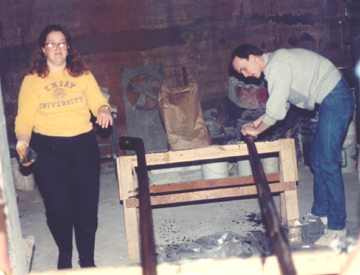
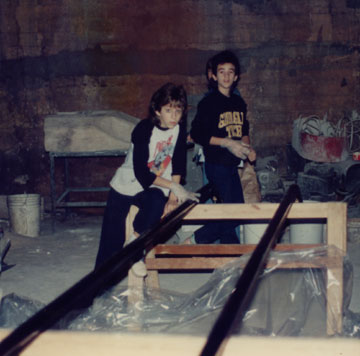 Restoring
Handrails
Restoring
Handrails
Another project we undertook was the renovation of the handrails
I had painted back in 1977. This time the work was done in a much
more proper fashion. After the rails were removed from their fittings,
they were taken downstairs into an area where they could be worked
on without fear of damaging the surrounding carpet or other
furnishings.
FOF began their renovation by using chemicals to properly strip
away all the layers of paint. To everyone's surprise, this revealed
a beautiful wood finish. Everyone was left to wonder why such
beautiful wood would have been covered by glossy paint.
It became generally agreed upon the most likely there were several
handrails that had been damaged pretty badly over the years and
in order to make the railings all look alike they were all painted
black. Yet one by one, we carefully removed the paint from each
of the railings and we could not find a single one that was damaged.
To our delight, all of the rails were in excellent shape. As each
one was cleansed of the black paint, they were lightly sanded,
stained, and given a coat of clear polyurethane sealant to protect
the wood. Since our initial work on the staircase railings, all
of the wood railings in the auditorium have also been stripped
of their black paint to match their brethren in the lobby areas.
The Spanish Room Project
We did work on the Spanish Room during its 1986-1988 transformation
into the concession area for the main auditorium. After the demolition
of the rehearsal rooms and restrooms was underway, we helped to
clear out the debris left behind from that work so construction
could continue. As part of that work, we built a frame that was
used a draped partition behind the glass windows of Bays 7 &
8 that were partially taken up by the Spanish Room expansion.
Once in place, this prevented people from seeing the unsightly
construction mess that occurred when the retail space was partially
torn out and rebuilt.
Once the Spanish Room was ready for service, FOF participated in the last part of that large project. The house staff had removed all of the electrical service and plumbing from the old round concession stand in the center of the lobby and FOF was left to knock it down to scrap. We smashed what remained of the stand and then carried its remains to the dumpster so it could be placed in a landfill.
Finishing Plasterwork
Friends of the Fox used the skills we learned from the cigarette
urn project to tackle another plaster job, but this time it was
a lot smaller than an urn. We spent several work sessions completing
gifts for contributors to the Fix the Fox project in the mid-1980s.
The house staff poured hundreds of plaster replicas of the metal
lion heads that are the waterspouts in fountains located in various
places in the building. Once removed from the molds, the plaster
replicas were given to FOF so we could sand, prime, paint, and
apply an antiquing effect to them. Once ready for its recipient,
the lion heads were given out to contributors that donated over
$250 to the Fox during their "Be Fabulous" campaign
in the mid-eighties.
We worked on those "Leon Heads" was we jokingly referred to them for several months. While it wasn't a true restoration project, we were happy to do it because we knew each one meant somebody had contributed a substantial gift to the Fox that allowed for the restoration work to continue.
Telemarketing
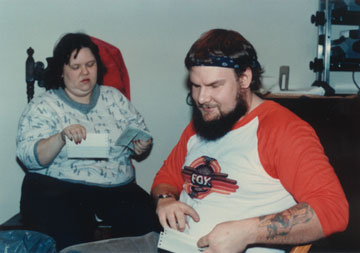 When
the Fox started their "Be Fabulous" fundraising campaign,
we were asked to do telemarketing to get Atlanta Landmarks members
to renew their dues. This was something that was totally not in
the concept of what FOF would do, but since it was for "the
cause" we gave it a shot. To be honest, none of us wanted
to do this as everyone knows how much we all hate telemarketers,
but because we were only contacting people who already were members
of Atlanta Landmarks, we took on the project. We would show up
in the evenings during the week and made the phone calls. I could
tell that David Granero, the House Manager and the one that was
supervising this project was not thrilled with our lack of enthusiasm
over the project. He tried to be nice about it, but you could
tell he felt we were not supporting him in this effort.
When
the Fox started their "Be Fabulous" fundraising campaign,
we were asked to do telemarketing to get Atlanta Landmarks members
to renew their dues. This was something that was totally not in
the concept of what FOF would do, but since it was for "the
cause" we gave it a shot. To be honest, none of us wanted
to do this as everyone knows how much we all hate telemarketers,
but because we were only contacting people who already were members
of Atlanta Landmarks, we took on the project. We would show up
in the evenings during the week and made the phone calls. I could
tell that David Granero, the House Manager and the one that was
supervising this project was not thrilled with our lack of enthusiasm
over the project. He tried to be nice about it, but you could
tell he felt we were not supporting him in this effort.
After about a month of several evenings making calls from the Fox, we all decided that FOF volunteers were not the best telemarketers around as the number of people that were renewing their memberships was much lower than what was expected.
Financial Contributions
When Friends of the Fox began, someone had designed a fancy logo
for the group to use. In retrospect, it really had nothing to
do with any of the decorative themes of the Fox. The logo had
a round stone like circle that sat in what best can be described
as a neon lit crown and its opposite underneath that looked very
much like the top of an old Wurlitzer jukebox from the 50s. Carved
into the stone was "Friends of the" with "FOX"
in rainbow colors on another layer above the stone. From behind
that was a pair of neon-like hands extended outwards to either
side.
Since I worked in the screen-printing industry, the companies I worked for printed T-shirts and sweatshirts with this logo on them. FOF sold the shirts to members and at several festivals that were held in Atlanta. I even struck up a deal for the shirts to be sold at several Camelot Record stores around the city. We raised several thousand dollars through the sale of our sportswear and we used this money to pay for any materials we needed for our work at the Fox.
Everyone loved the logo and we were very proud of it despite the fact it had nothing to do with Fox. Then one day to my horror, Rick Flinn showed me a logo in a magazine he discovered that had the same logo in it for an article on Wurlitzer jukeboxes. The logo was plagiarized. By that time, we were not selling sportswear any more, so we let the logo fade into the background.
After raising so much money from the sale of our sportswear, it became fairly obvious that the organization really didn't need any of its own capitol to finance projects. In that time, we took in a little over four thousand dollars and had spent less that one thousand in a four-year period and most of the expenditures had been for our recognition parties.
In the first five years of FOF member's work at the Fox, there had been three year-end parties to recognize the FOF membership's hard work at the Fox. One was held at the Women's Chamber of Commerce headquarters, another at the world headquarters of the Coca-Cola Company on North Avenue, and the last one was held in the Spanish Room of the Fox. While the Fox donated tickets to events and other small tokens of appreciation and allowed us to have our last party in the Spanish Room and provided food service for the party; no significant gesture of appreciation had been ever given to the individual FOF members from the Fox or Atlanta Landmarks.
While the WCC participated in FOF, they made sure to present certificates of appreciation or achievement to show some sort of thanks and appreciation to the members. When I became President of FOF, that marked the end of the WCC's involvement with FOF and we were on our own. During my second year as President, I decided that some grand gesture for our members that had worked so long and hard at the Fox needed was in order..
By this time in 1987, we still had our bank account with a little over three thousand dollars in it, which was not being used, nor did I feel we really needed. In my discussions with the other members of FOF the money should be given to the Fox for use on the Restoration efforts. This was a most fortunate time for everyone that we could make a sizeable contribution to the Fox. The Fox was now sponsoring a campaign called "Fix the Fox" in an effort to raise funds to continue restoration work on the building. As part of that campaign the Kressege Foundation, a non-profit charity organization, was offering a challenge grant that would match dollar for dollar any money donated to the Fox for restoration work. If we donated three thousand dollars at this time, the total amount the Fox would receive would be six thousand dollars. This was a sum that did not go unnoticed by the Fox Staff.
At the time, the Fox was "selling" auditorium seats with the least expensive seats costing $250 each. For that amount, you received a piece of paper that was laid out to look like a ticket. On it, you were thanked for your contribution and informed that an engraved brass plate was affixed to an armrest on a seat in the auditorium that had your name and organization's name engraved on it.
I got the great idea that by getting the Fox to "donate" some of those seats to the members of FOF, it would be a great heart-felt gesture to those who worked so hard on the Fox. While I wanted this to be as generous to the members of FOF, I had to devise a way so that those who had put in a few years of consistently coming to the Fox, the true "hardcores" would be recognized. I came up with two simple rules, you had to have been a member for at least 3 years and you have an attendance rate of at least 60%. Looking at the FOF rosters, there were 12 members that met those criteria. As it worked out, at $250 per seat, this would have required a donation of $3,000.
As you previous read, one of the first restoration tasks FOF undertook was the cleaning and polishing of the kiosk. As I said, after all our hard work the company that sealed the kiosk did a very inferior job on the kiosk and it had to be redone. Rick Flinn had taken bids to have the work redone and the one he was most comfortable with turned in an estimate of $2500.
The offer was made to donate our funds to the restoration fund and in return I would get 12 seats named after those FOF volunteers that met my criteria. There was just one minor problem we had to work around. In order for the money to be considered eligible for the matching grant, the funds had to go to the general restoration fund and not be earmarked for any specific purpose. But since we were not after having some sort of plaque or designation stating we paid for the kiosk restoration, we were promised that after the funds were donated, the Fox would bring in the restoration company to clean and seal the kiosk at a general restoration project.
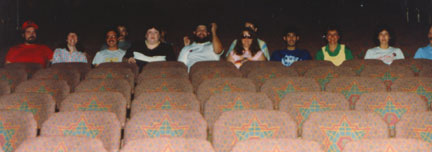
We got the seats, we paid for the completion of our very first
Fox restoration project, the Fox got a shiny kiosk, FOF's checking
account was closed, and the club was broke. Everyone was happy!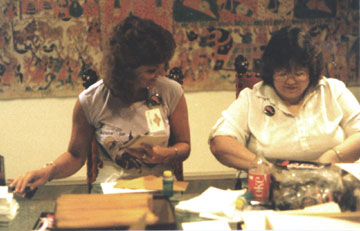
Sorting out the Archives and Research
Towards the end of my tenure as President, we found ourselves
at a crossroads. There was few projects left that volunteers could
do in a single monthly meeting of three hours. The building's
financial picture was such that restoration could be best handled
by a paid fulltime staff more efficiently than by a volunteer
effort.
FOF soon found itself doing work in the Fox's massive archive room. Our new task was to help sort and catalog all the things that were contained in the archives. A lot of stuff was thrown haphazardly into the room and there was no true sense of structure to what treasures the archive held. Along with a college intern, Fran Mulcay, we began the task. Along with an intern who was also working on the archive, we started to make sense of the room.
The archives was something that was very close to my heart. It was the only true historical record of the Fox and over time, it was treated as nothing more than a junk room. For some time I had expressed a big interest in letting FOF be put in charge of organizing the collection, but it never came to be. In 1996, the Fox suffered a terrible fire that was located not too far away from the archive room. While all of Rick Flinn's records that were located in the upper offices were lost, the archive suffered very minor damage. When the front quarter-section of the building was rebuilt, a purpose-built archive room was constructed and the Fox's hisotrical collection was finally given it's proper home. The room is reportedly fire-safe and climate controlled. Now that everything has a proper place and is fully cataloged, I'm hopeful that more of the treasures in the archive will be seen more often.
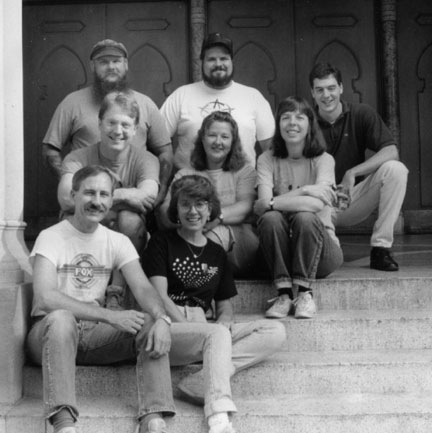 As
time
progressed, the active membership of FOF slowly dwindled. We first
lost a lot of our members that were also members of the Women's
Chamber of Commerce when the WCC withdrew its support from FOF. By
the late 1980s, Our active membership roster was down to about 30. By the time our work at the Fox ended, that number was
down to about
15.
As
time
progressed, the active membership of FOF slowly dwindled. We first
lost a lot of our members that were also members of the Women's
Chamber of Commerce when the WCC withdrew its support from FOF. By
the late 1980s, Our active membership roster was down to about 30. By the time our work at the Fox ended, that number was
down to about
15.
As our manpower dwindled, the number of restoration projects we could work on also declined. When FOF Began, the Fox was still watching its budget tightly and volunteers were a way to stretch restoration funds. But as the Fox became more profitable, the restoration budget grew as well as the Fox's restoration staff. Since FOF only met once a month, it became impractical to let volunteers work on a multi-day project that could get stretched into taking months to do when a paid staff member could do the same project in less than a week's time.
I should acknowledge there were some at the Fox that had little regard for FOF. Part of that was because of our monthly chedule. A few staff members held FOF in such low regard that they felt we were more of a social group that got together for coffee and doughnuts at the Fox rather than being a true asset the Fox valued. I think that hit its peak when we were recruited to telemarket Atlanta Landmark members to renew their memberships. All of us at FOF did not want to do it as we all hate getting those types of calls, but we did do it albeit begrudgingly due to our love of the Fox.
Rick Flinn was able to find restoration work for do over the years that kept us going, and we appreciated it. Our last long-term project in the Fox was organizing the fabled "Fox Archives". The Archives were basically become two rooms full of things below the auditorium locarted next to the theater's rehearsal room. Items that were deemed worth keeping were tossed into the rooms and essentially forgotten. We spent a good deal of time in the archives and I did feel we were performing a really valuable task for the Fox. Shortly after we started on the rooms, Fran Mulcahy came in as a college intern to help organize the tons of stuff in the room.
After we worked in the archives for more than a year, it was suggested that as part of this project, FOF could hold meetings at the Atlanta Public Library in order to research newspapers for reports about the Fox that had appeared in the Atlanta Journal and Atlanta Constitution over the years. It was slow and admittedly boring work. For those like me who loved having a hands-on relationship with the Fox, it felt like the Soviets had banished me to the coldest regions of Siberia. Yet month after month, FOF members gathered at the library and faithfully did the research.
Once we were out of the building and doing research work at the library, FOF never met again at the Fox. In the fall of 1992, I was planning to relocate to Oregon. At the same time Rick Flinn, had resigned from his position as the Fox's Restoration Director. FOF decided to give Rick and myself, a farewell party at Mick's Restaurant a block away from the Fox.
Two months later, my planned move fell apart and I wound up remaining in Atlanta. While Rick Flinn retained a board position with Atlanta Landmarks, Mary Catherine Martin took his former position as Restoration Director and Beth Ruddiman continually tried to work with her to get FOF doing projects once more for the Fox. Her telephone calls were never returned and it was the general opinion of all the remaining FOF members that it had been decided by the Fox Staff that FOF was no longer needed and our offers of volunteer service were now being ignored in hope that we would just go away.
 Since that time, the core membership of FOF still meet on a quarterly
to catch up on what's been happening and to reminisce about our
time at the Fox. From what was a group of almost 200 people when
it first started, there were still 12-15 FOF members in the group:
Ed Kuehn, Beth Ruddiman, Paula Pavlosky, Larry Peters, Rob Woodyard,
Pete Wentzell, Rachel Lehmann, Rick Flinn, and myself.
Since that time, the core membership of FOF still meet on a quarterly
to catch up on what's been happening and to reminisce about our
time at the Fox. From what was a group of almost 200 people when
it first started, there were still 12-15 FOF members in the group:
Ed Kuehn, Beth Ruddiman, Paula Pavlosky, Larry Peters, Rob Woodyard,
Pete Wentzell, Rachel Lehmann, Rick Flinn, and myself.
Rick Flinn's schedule is so busy, we rarely get to see him. He has gone on to do some really important and amazing work. He was involved in the renovation and restoration of several important Atlanta historical buildings. Now his work is truly international as he is spending time in both Atlanta and Paris, France where he is working on several buildings there!
During the eleven years FOF worked at the Fox, several of us developed strong bonds to one another that we were not about to give up. This is why we stated meeting on a quarterly basis for brunch to talk about all sorts of topics that were going on in our lives. When one of us sees an article on the Fox in the paper, it is brought to discuss at our gatherings. This is a tradition that has now gone on for 18 years; much longer than we actually did work at the Fox.
Sadly, with time comes age and loss. One of our first members to
join was Rachel Lehman. Back then, she was a spry 70-something that was
full of life, and vigor. She was a constant in our lives and so
wonderful, I cannot even attempt to describe it in words. While she was
"retired" and living in Atlanta's Jeiwsh Towers, she held a prominant
post with the Atlanta Opera Society. She never slowed down until she
after she celebrated her 101st birthday. By the time she celebrated her
103rd birthday, you could tell she was slowing down just a bit, but she
was still full of life and even enjoying a new boyfriend! In the spring
of that year, Her niece Didi Conn ("the Actress") brought her to what
turned out to be our last brunch together. She was so proud of Didi and
just had to tell everyone who she was. You could tell Didi loved her
aunt emmesely and endured it all with pride to make Aunt Rachel happy.
After a couple of health emergencies, Rachel passed on just a few days
shy of her 104th birthday. While it was indeed a time of sadness, I had
to celebrate what an incredible life Rachel had and how blessed I was
to have had her in my life for a short time.
